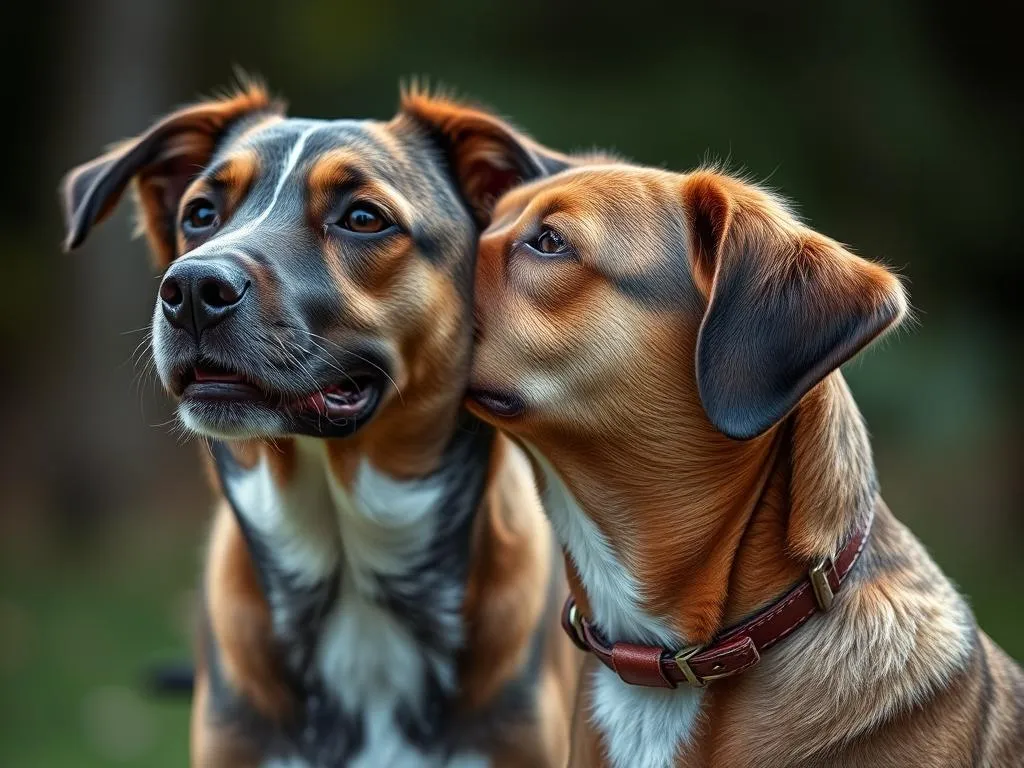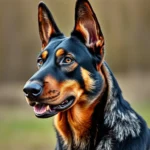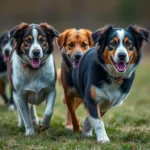
Dogs are often heralded as “man’s best friend,” but their remarkable sense of smell is one of the key traits that elevate their status. While humans rely primarily on vision, dogs depend heavily on their olfactory capabilities to navigate their world. Their noses are equipped with an intricate olfactory system that enables them to detect scents with astounding precision. Understanding which dog breeds with the best sense of smell exist can provide insight into their roles in various fields, from law enforcement to medical detection.
Understanding Canine Olfaction
The Anatomy of a Dog’s Nose
A dog’s nose is a marvel of nature, designed specifically for detecting scents. Dogs possess approximately 220 million olfactory receptors in their noses, compared to a human’s 5 million. This difference allows dogs to detect scents at incredibly low concentrations. Moreover, the structure of a dog’s nose includes a special organ known as Jacobsen’s organ, or the vomeronasal organ, which helps them pick up pheromones and other chemical signals.
To put this into perspective, the area of the olfactory epithelium in a dog’s nose is about 20 times larger than that of a human. This anatomical advantage makes dogs unparalleled in scent detection, enabling them to distinguish between different smells and even identify the emotional state of another creature by scent alone.
How Dogs Use Their Sense of Smell
Dogs process scents in a way that is vastly different from humans. When a dog inhales, they can differentiate between multiple scents due to the structure of their nasal cavity. Each scent is analyzed by various olfactory receptors, allowing dogs to “see” the world through smells. This ability is crucial for communication among dogs, navigation in their environment, and hunting for food.
Scent plays a vital role in a dog’s life. It allows them to interpret the world around them, find food, and recognize the presence of other animals or humans. In many cases, dogs can even identify specific people or objects simply by smell, showcasing their incredible olfactory memory.
Factors Affecting a Dog’s Sense of Smell
Several factors can influence a dog’s olfactory abilities. Age is a significant factor; as dogs get older, their sense of smell can diminish, just like in humans. Additionally, certain breeds are genetically predisposed to have stronger olfactory capabilities than others. Health issues, such as respiratory problems, can also impair a dog’s ability to smell effectively. Finally, training plays a critical role in honing a dog’s natural scent detection skills, allowing them to excel in specific tasks.
Top Dog Breeds with the Best Sense of Smell
Bloodhound
The Bloodhound is often considered the gold standard when it comes to scent detection. Known for their droopy ears and wrinkled skin, these dogs have an extraordinary sense of smell that can track scents over great distances. Bloodhounds have been used in search and rescue operations as well as in tracking criminals. Their ability to follow a scent trail, even days later, is unparalleled, making them invaluable in forensic investigations.
German Shepherd
The German Shepherd is another breed renowned for its olfactory talents. This versatile breed is not only intelligent but also highly trainable, making it a favorite among law enforcement agencies worldwide. German Shepherds are commonly used in search-and-rescue operations and have proven effective in detecting drugs and explosives. Their keen sense of smell, combined with their protective instincts, makes them ideal for police work.
Labrador Retriever
Labrador Retrievers are beloved family pets, but they also possess one of the best senses of smell among dog breeds. Their amiable temperament makes them highly trainable, allowing them to excel in various detection roles, such as narcotics and explosives detection. Labs are often employed in airports and other security settings for their ability to sniff out dangerous substances efficiently.
Beagle
The Beagle is a small to medium-sized breed with an extraordinary sense of smell, making them excellent scent detection dogs. Historically bred for hunting, Beagles have been used in various scent detection roles, including tracking contraband at customs. Their friendly demeanor and strong hunting instincts allow them to excel in both professional and recreational scent work.
Belgian Malinois
The Belgian Malinois is a breed known for its agility and intelligence. Frequently used in police and military operations, these dogs have a powerful sense of smell that aids in drug detection and search-and-rescue missions. Their ability to work in high-pressure situations sets them apart, making them a favorite choice for task-oriented roles.
Springer Spaniel
The Springer Spaniel is another breed with a keen olfactory sense, prized for its abilities in hunting and detection. Known for their energetic nature, these dogs excel in search and rescue operations as well as in detecting specific scents. Their background as hunting dogs has honed their skills, making them effective in various scent detection tasks.
Coonhound
Coonhounds are a group of breeds known for their exceptional tracking abilities. They have a strong sense of smell and are often used in hunting and tracking scenarios. With their unique vocalizations and determination, Coonhounds are particularly skilled at scent work, often participating in field trials that showcase their olfactory prowess.
Applications of Dogs with Exceptional Smell
Search and Rescue Operations
Dogs trained for search and rescue utilize their powerful noses to locate missing persons. These dogs undergo rigorous training, learning to identify specific scents associated with humans. Successful missions often involve locating individuals in disaster-stricken areas or finding lost hikers. Case studies have demonstrated the effectiveness of dogs in locating individuals who may be trapped or injured, showcasing their invaluable role in emergency response teams.
Law Enforcement and Detection Work
In law enforcement, dogs play a crucial role in detecting illegal substances and explosives. Dogs are trained to recognize specific scents associated with drugs or bombs, assisting police in various operations. Examples of successful drug busts or bomb detections highlight how these canines enhance safety and security in communities.
Medical Detection
Remarkably, dogs are also trained to detect medical conditions such as cancer, diabetes, and even seizures. Research studies support the idea that dogs can sense chemical changes in the human body through scent. Medical detection dogs are trained to identify specific odors associated with certain health conditions, providing critical assistance in healthcare settings.
Conservation and Wildlife Protection
Dogs are increasingly being used in conservation efforts, particularly in tracking endangered species or locating invasive plants. Their sense of smell aids in wildlife protection initiatives, where they help researchers monitor populations or track poachers. These dogs contribute significantly to environmental conservation, showcasing the versatility of their olfactory skills.
Training Techniques for Scent Detection
Basic Training Principles
Training a dog for scent detection begins with basic obedience commands. Positive reinforcement is crucial, as it encourages dogs to associate specific behaviors with rewards. Commands such as “sit,” “stay,” and “come” are foundational for building a dog’s focus and discipline, which are essential in scent work.
Advanced Scent Training Methods
Once a dog has mastered basic commands, advanced training can begin. This may involve exposing the dog to various scents and teaching them to recognize and alert their handler to specific odors. Techniques such as scent discrimination, where dogs learn to differentiate between similar smells, can be employed. Socialization and exposure to different environments are also critical for a well-rounded scent detection dog.
Common Challenges in Scent Training
Scent training can present challenges, such as distractions from other scents or the environment. Handlers may encounter issues like a lack of focus or overstimulation in dogs. Solutions include gradual exposure to various scenarios and consistent reinforcement of training principles to help dogs overcome these challenges.
Choosing the Right Breed for Scent Work
Factors to Consider
When selecting a dog breed for scent work, it’s essential to consider lifestyle factors. Active individuals or families with ample space may thrive with energetic breeds, while those with a more sedentary lifestyle might prefer a calmer dog. Additionally, the time commitment for training and exercising the dog is crucial in ensuring a successful partnership.
Matching Dog Breeds to Scent Work Goals
Understanding the strengths and weaknesses of different breeds is vital. Some breeds excel in tracking, while others may be better suited for detection roles. Matching the dog’s abilities to specific scent detection tasks ensures a more effective and enjoyable experience for both the handler and the dog.
Conclusion
Selecting a breed with a strong sense of smell is paramount for those interested in scent detection work. The breeds discussed here—the Bloodhound, German Shepherd, Labrador Retriever, Beagle, Belgian Malinois, Springer Spaniel, and Coonhound—each possess unique capabilities that make them exceptional in their fields. The invaluable role of scent detection dogs spans multiple sectors, from law enforcement to medical detection, and their contributions cannot be overstated. Understanding these breeds and their olfactory abilities opens the door to appreciating the profound bond between humans and dogs—one built on trust, training, and the shared joy of working together.









